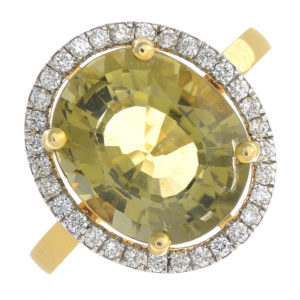Emma Testill, Catalogue Manager from the Jewellery Department at Fellows Auctioneers, has been researching the birthstone for October.
October Birthstone - Opal
Opal is believed to take its name from the Indian Sanskrit word ‘upala,’ meaning ‘precious stone’. Opals are categorised based on their appearance some of the main varieties being; precious, common, boulder and fire. *Precious opals display a fantastic ‘play-of-colour’ as light is refracted within the internal silica spheres, creating a display of spectral colours.
Common opals are translucent to almost opaque with a milky appearance, in a range of hues which include blue, orange and green. Boulder opals are a seam of precious opal that are too thin to be removed from the host rock. Fire opals are a translucent orangish-red hue, prized for its play-of-colour along with an enchanting body colour.
 Emma Testill, Catalogue Manager from the Jewellery Department at Fellows Auctioneers
Emma Testill, Catalogue Manager from the Jewellery Department at Fellows Auctioneers
The ancient Greeks believed that opals were formed from the tears of joy wept by Zeus when he defeated the titans, and that the opal bestowed prophetic powers. Opal was the favourite gemstone of Queen Victoria, she was often pictured wearing them throughout her reign.
Opal is the national gemstone of Australia; the country itself is the world's main source of precious opals, most notably in Coober Pedy. Other significant locations are Ethiopia, USA and Mexico. The largest opal ever discovered is the ‘Olympic Australis,’ it has remained uncut and in its natural state, weighing a massive 17,000 carats.
A selection of opals can be found in our October jewellery sales.
October Birthstone - Tourmaline
Tourmaline acquired its name from the Sinhalese word ‘turmali,’ meaning ‘mixed coloured crystals'. Egyptian legend tells how tourmaline made its way from the centre of the Earth and whilst it passed over a rainbow, collected all the colours for its own. In the 1700s it was discovered that tourmaline had pyroelectric properties, the ability to attract hot ashes from coals and also repel them. The Dutch East India company brought the ‘Ceylonese magnet’ as it was known over to Europe as part of a series of curiosities.
 A yellow tourmaline and diamond cluster ring
A yellow tourmaline and diamond cluster ring
First discovered on the island of Elba, where notable gem quality tourmalines are part of the ‘Elbaite’ species; these are then categorised further based on their colour group; three popular examples being Rubellite, Paraiba and Indicolite. Rubellite tourmalines are vivid pink-red in colour, and can found in locations such as Afghanistan and Madagascar.
Paraiba tourmalines are neon blue-green colour, traditionally only found in Brazil. Indicolite tourmalines are medium to deep blue in colour, and can found in Brazil and USA. Often gifted on an 8
th wedding anniversary. The largest and also record breaking Paraiba tourmaline, is the ‘Ethereal Carolina Divine Paraiba’ weighing an impressive 191.87 carats.
Always a popular gemstone in our jewellery sales, we have many highlight pieces in October.
 Emma Testill, Catalogue Manager from the Jewellery Department at Fellows Auctioneers
Emma Testill, Catalogue Manager from the Jewellery Department at Fellows Auctioneers A yellow tourmaline and diamond cluster ring
A yellow tourmaline and diamond cluster ring Emma Testill, Catalogue Manager from the Jewellery Department at Fellows Auctioneers
Emma Testill, Catalogue Manager from the Jewellery Department at Fellows Auctioneers A yellow tourmaline and diamond cluster ring
A yellow tourmaline and diamond cluster ring